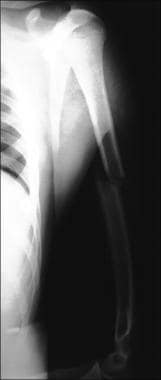Background
In evaluating humerus injuries, classifying the fracture and, if necessary, reducing and immobilizing the fracture are essential.
Classification systems
Classification systems include Riseborough and Radin, which classifies distal humerus fractures according to the state of the condylar fragments; Lecestre et al, which defines supracondylar, extra-articular condylar, articular intercondylar, and comminuted fractures; Jupiter, which is based on intraoperative observations, describing high T, low T, Y, H, medial, and lateral lambda fractures; and Dubberley, which distinguishes between fracture types involving the capitellum and trochlea and comprises techniques for treatment. Internationally, the American Academy of Orthopaedic Surgeons (AAOS) classification is most commonly used, categorizing fractures as extra-articular, partial articular, and articular. [1]
The Neer classification system is the commonly used terminology to describe proximal humerus fractures. [2] The Neer classification for proximal humerus fractures is based on 4 fracture parts: the greater tuberosity, the lesser tuberosity, the humeral head, and the humeral shaft. If any of the 4 segments is separated by more than 1 cm from its neighbor or is angulated more than 45°, the fracture is said to be displaced. One-part fractures are nondisplaced fractures or fractures with minimal displacement. Two-part fractures are fractures in which only a single segment is displaced in relation to the other three. Three-part fractures occur when two segments are displaced in relation to the other two parts. Four-part fractures exist when all the humeral segments are displaced. [3]
Etiology
Humerus fractures are caused by direct trauma to the arm or shoulder or by axial loading transmitted through the elbow. Attachments from pectoralis major, deltoid, and rotator cuff muscles influence the degree of displacement of proximal humerus fractures.
Humeral stress fractures occur with overhead throwing and occasionally with violent muscle contractions. These types of fractures are documented most commonly in baseball. As with other stress fractures, an increase in activity or stress on immature or unconditioned bone is the likely culprit. [4]
The most common cause of proximal humeral fractures is a fall from standing, followed by motor vehicle accident and a fall involving stairs. Additional mechanisms include violent muscle contractions from seizure activity, electrical shock, and athletic-related trauma. Proximal humeral fractures are most often closed.
Causes of humeral diaphyseal fractures include a fall from standing, a motor vehicle accident, a fall from height, and pathology related.
Distal humerus fractures are primarily caused by high-energy trauma; in elderly persons, they most often result from low-energy falls.
Epidemiology
Humeral diaphyseal fractures account for 1.2% of all fractures. Proximal humerus fractures account for 5.7% of all fractures. [5]
Proximal humerus fractures are more common in elderly persons, with the average age of 64.5 years, [6] and are the third most common fracture after hip fractures and distal radius fractures. [7] Approximately 85% of proximal humerus fractures occur in individuals older than 50 years. [8]
Humeral diaphyseal fractures occur in a slightly younger population, with the average age being 54.8 years. [6]
In adults, fractures of the distal humerus account for approximately 2% of all fractures and a third of all humerus fractures.
See the image below.
Fracture patterns are similar across all ages, though older people are more prone to fracture because of osteoporosis. A humerus fracture in a child with an inconsistent injury mechanism should raise suspicion for abuse and trigger further investigation.
Young patients presenting with humeral diaphyseal fractures after high-energy injuries frequently have multiple injuries. Approximately 5% of these patients with humeral diaphyseal fractures present with spinal fractures or complex foot fractures, and about 4% present have pelvic or proximal tibial fractures. [6] Older patients tend to present with other fractures in the ipsilateral arm, usually distal radius fractures. [6]
In an epidemiologic survey of 1800 low-energy humeral fractures in an emergency department in Parma, Italy, the following were identified [9] :
-
Predominance in women: 78%.
-
Fractures of the proximal humerus represented the largest majority of humerus fractures: >85 %.
-
Incidence progressively increased with age (more than 60-fold in women and 20-fold in men).
-
Simultaneous fractures (hip in particular) were frequent, especially after 85 years of age (1 out of 8 cases).
Prognosis
For proximal humerus fractures, complete union is expected at 6-8 weeks. Older patients often exhibit a functional decrease in shoulder range of motion (ROM). Diaphyseal fractures have a high rate of union. Residual angulation is well tolerated because of compensation by shoulder and elbow ROM.
Rarely, vascular or nerve injuries are associated with humerus fractures. Radial nerve palsy associated with fractures of the shaft of the humerus is the most common nerve lesion complicating fractures of long bones. [10]
Complications
Proximal humerus fracture
The most common complication of proximal humerus fracture is adhesive capsulitis. This can be prevented by the early initiation of a rehabilitation program. Two-part fractures of the articular surface and 4-part fractures have a high incidence of avascular necrosis of the humeral head. Repeated forceful attempts at reduction of a fracture dislocation may be associated with subsequent heterotropic bone formation.
About 15% of patients with proximal humerus fractures have persistent functional deficits that affect quality of life. [11]
Humeral shaft fracture
The most common complication in humeral shaft fractures is radial nerve injury. The nerve deficit is usually a benign neurapraxia that resolves spontaneously, although recovery may take several months. Radial nerve injuries associated with penetrating trauma or open fractures are likely to be permanent and usually warrant operative exploration.
Claessen et al conducted a study to determine the factors associated with radial nerve palsy in patients with diaphyseal humerus fracture. In a study of open fractures, location of fracture and high-energy trauma were significantly associated with radial nerve palsy (84 of 325 patients [26%]). According to the study, iatrogenic transient dysfunction of the radial nerve occurs in approximately 1 in 5 patients who are treated with lateral exposure of the humerus, in 1 in 9 patients treated with posterior exposure, and in 1 in 25 patients treated with an anterolateral exposure. [10]
-
Diaphyseal humerus fracture.
-
Neer classification.


